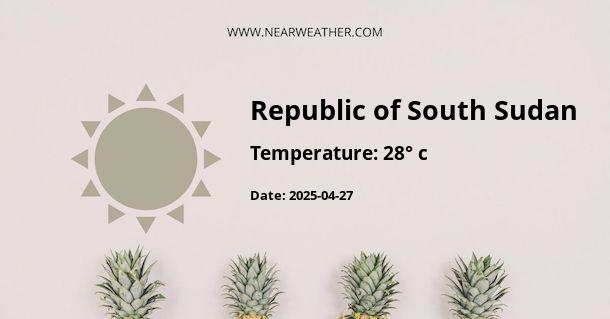South Sudan Climate and Weather Overview
South Sudan, located in East-Central Africa, experiences a diverse climate, influenced by its geography and the prevailing winds. The country is characterized by a tropical climate with distinct wet and dry seasons. Understanding the weather patterns is crucial for visitors and residents alike, as it impacts agriculture, infrastructure, and daily activities.
South Sudan Weather by Season
South Sudan experiences three main seasons: a hot and dry season, a rainy season, and a cooler dry season. Let's take a closer look at each season.
Hot and Dry Season (December to March)
During the hot and dry season, South Sudan experiences high temperatures and minimal rainfall. The average temperature ranges from 32°C to 38°C (90°F to 100°F), and the low humidity levels contribute to the arid conditions. This season is characterized by clear skies and abundant sunshine, making it the peak of the dry season.
Rainy Season (April to October)
The rainy season in South Sudan brings heavy rainfall and increased humidity. The average rainfall ranges from 800mm to 1200mm (31.5 to 47 inches) annually, with the highest precipitation occurring between June and September. The temperature during this season ranges from 25°C to 30°C (77°F to 86°F), providing relief from the intense heat of the dry season.
Cooler Dry Season (November to February)
During the cooler dry season, South Sudan experiences milder temperatures as the country transitions from the rainy season to the next hot and dry season. The average temperature ranges from 21°C to 27°C (70°F to 81°F), offering a reprieve from the heat while still maintaining dry conditions.
South Sudan Regional Variations
South Sudan's climate and weather patterns can vary across the country's regions. The northern areas, closer to the Sahara Desert, experience hotter and drier conditions, while the southern regions may receive higher amounts of rainfall due to their proximity to the equatorial belt. These regional variations contribute to the country's diverse climate.
Impact of Weather on South Sudan
The weather in South Sudan plays a significant role in the daily lives of its residents and the overall economy. The agricultural sector heavily relies on the seasonal rainfall for crop cultivation, with the rainy season being crucial for farming activities. Additionally, the weather impacts infrastructure and transportation, as heavy rainfall can lead to flooding and road disruptions.
South Sudan Climate Data
Let's dive into some specific climate data for South Sudan to provide a comprehensive understanding of the country's weather patterns.
| Month | Temperature (°C) | Rainfall (mm) |
|---|---|---|
| January | 32-38°C | 0-5mm |
| April | 25-30°C | 50-100mm |
| July | 25-30°C | 200-400mm |
| October | 25-30°C | 100-200mm |
The table illustrates the average temperature and rainfall for key months in South Sudan, reflecting the distinct seasonal variations in weather.
Conclusion
South Sudan's climate presents a dynamic interplay of hot and dry conditions, heavy rainfall, and milder temperatures across different seasons. Understanding the climate and weather patterns is essential for both residents and visitors to navigate daily activities and plan agricultural endeavors. By acknowledging the regional variations and the impact of weather on various sectors, South Sudan can better prepare for and adapt to its climatic conditions.
A - Republic of South Sudan's Latitude is 4.840230 & Longitude is 31.594280.
A - Weather in Republic of South Sudan is 25° today.
A - Climate Conditions in Republic of South Sudan shows light rain today.
A - Humidity in Republic of South Sudan is 75% today.
A - Wind speed in Republic of South Sudan is 7.42 km/h, flowing at 201° wind direction. today.
